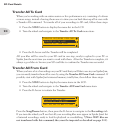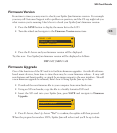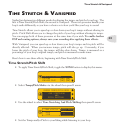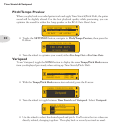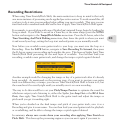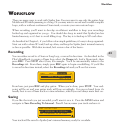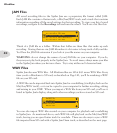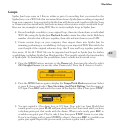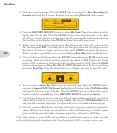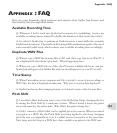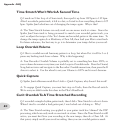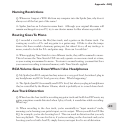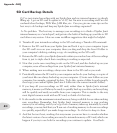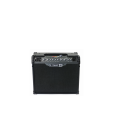
Appendix : FAQ
A•3
Naming Restrictions
Q: Whenever I import a WAV file from my computer into the Spider Jam, why does it
always cut off the last part of the name?
A: Spider Jam has an 8-character name limit. Although your original file name will
remain unchanged on your PC, try to use shorter names for files whenever possible.
Routing Goes To Mono
Q: I recorded a vocal on the Mic/Aux track, and a guitar on the Guitar track. I’m
routing my vocal to a P.A. and my guitar to a guitar amp. I’d like to slow the tempo
down a bit then overdub a harmony guitar part, but when I do so, all my tracks go to
mono, routed to both the P.A. and guitar amp. How can I avoid this?
A: When applying Time Stretch to two different tracks, they will be summed to mono.
This is because the Time Stretch DSP can only operate on one mono track at a time,
so your routing was summed to mono. To return to normal routing, you must first Save
your current recording to internal memory with Time Stretch applied.
RCA Volume Goes Down When I Use Headphones
Q: My Spider Jam RCA outputs feed my mixer at a very good level, but when I plug in
my headphones my RCAs’ level goes way down. What’s happening?
A: The Spider Jam RCAs normally send 100% level, but when you plug in headphones
they’re controlled by the Master Volume, which is probably set to a much lower level.
Aux Track Distortion
Q: When I use the Aux track for recording my guitar track and I add Aux FX Presets, my
guitar sometimes sounds distorted when I play it back; it sounds fine while recording.
What’s up?
A: When recording to the Aux track, you’re essentially in “input monitor” mode,
meaning you’re hearing your guitar’s input, not its output. When you add Aux FX like
EQ, for example, you’re also boosting level. This can result in distortion that you only
hear on playback. The cure for this is, if you’re recording on the Aux track and you’re
boosting your level with Aux FX, simply lower your input level to avoid distortion.



